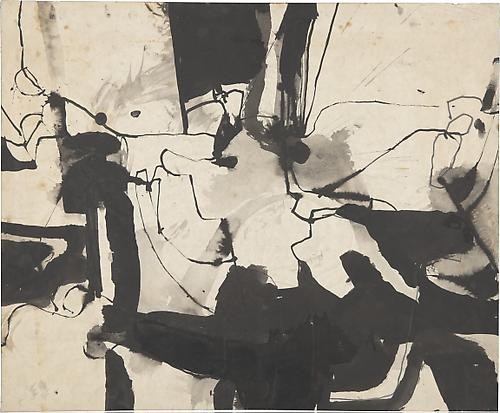Richard Diebenkorn
05 May - 25 Jun 2010
RICHARD DIEBENKORN
Paintings and Drawings 1949-1955
May 5 - June 25, 2010
Catalogue Available
Greenberg Van Doren Gallery is pleased to present an exhibition of paintings and works on paper from 1949 – 1955 by Richard Diebenkorn (1922 – 1993). Organized in cooperation with the Estate of Richard Diebenkorn, this exhibition will feature thirty-six works many of which, until now, have only been seen in museum exhibitions including the 1988-89 MoMA show The Drawings of Richard Diebenkorn and the Harwood Museum of Art's Richard Diebenkorn in New Mexico from 2007-08.
Diebenkorn's early works from the late 40s through the mid 50s are among the finest examples of postwar American abstraction. Characterized by calligraphic lines and shifting fields of color, these works reflect both the broader interest in abstraction shared among many artists of the period and the diverse landscapes in which Diebenkorn lived during these years. Diebenkorn left Sausalito, California in 1949 to pursue his graduate degree in art at the University of New Mexico in Albuquerque. In 1952 he moved again to Urbana, Illinois to teach and then, in 1952, returned to California where he settled in Berkeley. Each new surrounding provoked a change in the artist's palette and in the overall rhythm of his compositions.
The earliest works on canvas and paper reflect a certain map like quality, perhaps as a result of Diebenkorn's work in the military service as an aerial topographical draftsman. Broad areas of color, often rectilinear, ranging from gray to soft pink to adobe red comprise the composition of Albuquerque #5, 1951. Into these fields of color are inserted organic invented forms defined by a black line. At times the line grows into elongated shapes painted around one another as in The Green Huntsman, 1952. In the works from the Berkeley period such as Berkeley #25, it appears that the artist has righted the picture plane parallel to the viewer as a horizon line creeps into the composition. Softer hues give way to orange, blue and green. Eighteen black and white drawings on paper explore all the permutations of mark making and brushstroke found in the canvases.
Paintings and Drawings 1949-1955
May 5 - June 25, 2010
Catalogue Available
Greenberg Van Doren Gallery is pleased to present an exhibition of paintings and works on paper from 1949 – 1955 by Richard Diebenkorn (1922 – 1993). Organized in cooperation with the Estate of Richard Diebenkorn, this exhibition will feature thirty-six works many of which, until now, have only been seen in museum exhibitions including the 1988-89 MoMA show The Drawings of Richard Diebenkorn and the Harwood Museum of Art's Richard Diebenkorn in New Mexico from 2007-08.
Diebenkorn's early works from the late 40s through the mid 50s are among the finest examples of postwar American abstraction. Characterized by calligraphic lines and shifting fields of color, these works reflect both the broader interest in abstraction shared among many artists of the period and the diverse landscapes in which Diebenkorn lived during these years. Diebenkorn left Sausalito, California in 1949 to pursue his graduate degree in art at the University of New Mexico in Albuquerque. In 1952 he moved again to Urbana, Illinois to teach and then, in 1952, returned to California where he settled in Berkeley. Each new surrounding provoked a change in the artist's palette and in the overall rhythm of his compositions.
The earliest works on canvas and paper reflect a certain map like quality, perhaps as a result of Diebenkorn's work in the military service as an aerial topographical draftsman. Broad areas of color, often rectilinear, ranging from gray to soft pink to adobe red comprise the composition of Albuquerque #5, 1951. Into these fields of color are inserted organic invented forms defined by a black line. At times the line grows into elongated shapes painted around one another as in The Green Huntsman, 1952. In the works from the Berkeley period such as Berkeley #25, it appears that the artist has righted the picture plane parallel to the viewer as a horizon line creeps into the composition. Softer hues give way to orange, blue and green. Eighteen black and white drawings on paper explore all the permutations of mark making and brushstroke found in the canvases.

